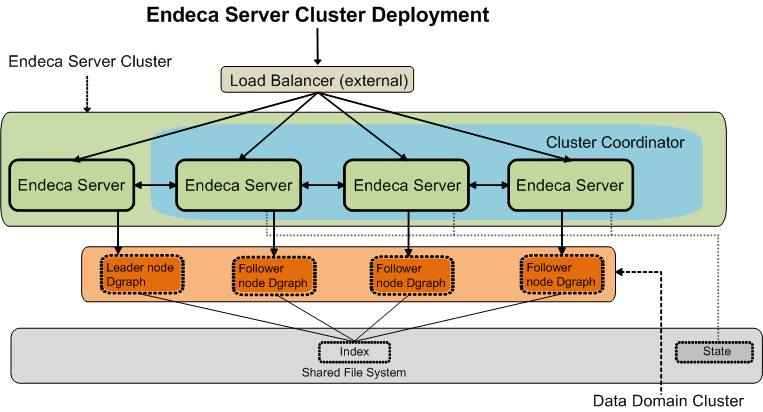The diagram in this topic illustrates a clustered Endeca Server deployment serving a single data domain cluster.

In this diagram, starting from the top, the
following components of the Endeca Server cluster deployment are included:
- The external load balancer
serves as the single point of entry to the Endeca Server cluster. All requests
to the single hosted data domain cluster go through this load balancer.
Note: Although it is recommended to use an external load balancer in your deployment, it is optional. For information, see Load balancing and routing of requests.
- The Endeca Server cluster comprises a set of four Endeca Server nodes. All Endeca Server nodes in the cluster are aware of one another.
- Three out of four Endeca Server nodes are hosting the Cluster Coordinator instances. The Cluster Coordinator maintains a cluster state for all participating members of the Endeca Server cluster.
- A single data domain cluster consisting of four Dgraph nodes is hosted on the four Endeca Server nodes.
- Each node in this data domain cluster is represented by the Dgraph process running on each of the Endeca Server nodes. In this example, there is a one-to-one mapping between the data domain nodes and the Endeca Server nodes hosting them.
- In the data domain cluster that is not configured as read-only, exactly one node serves as the leader node, and the remaining nodes are follower nodes. For definitions of leader and follower nodes, see Data domain cluster concepts.
- Finally, all nodes in the data domain cluster have write access to a shared file system on which the index for the data domain is stored. Only the leader Dgraph node in any data domain cluster is allowed to write to the index located on the file system. Follower Dgraph nodes can only read from the index. On the diagram, the index resides on the shared file system. The cluster state is also maintained in the shared file system by the Cluster Coordinator.
